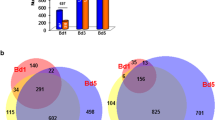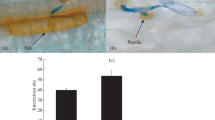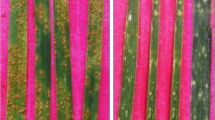Abstract
Dirigent proteins regulate coupling of monolignol plant phenols to generate the cell wall polymers lignins and lignans that are involved in structural fortification and defense against pathogens and pests. In this study, we report the temporal expression of a putative Hessian fly-responsive disease resistance dirigent-like protein-encoding gene, HfrDrd, in wheat. HfrDrd transcript abundance was quantified under biotic stresses imposed by Hessian fly, bird cherry-oat aphid, barley and cereal yellow dwarf virus, fall army worm and silverleaf white fly, after mechanical wounding, as well as during treatment with signaling elicitors. Quantitative transcriptional analysis indicated increased abundance of HfrDrd mRNA in both susceptible and resistant wheat after Hessian fly attack. However, within 24 h, resistant wheat accumulated 2.5- to >20-fold higher HfrDrd mRNA levels than the susceptible wheat. The increase in transcripts as early as 2 h after egg hatch suggested a role for HfrDrd in early defense against Hessian fly larvae. HfrDrd transcript abundance was not responsive to exogenous application of plant defense-signaling pathway molecules, salicylic acid, methyl jasmonate or abscisic acid. Lack of HfrDrd response during other wheat–insect interactions or mechanical wounding indicated that HfrDrd is not a general stress-responsive gene, but is specific to the defense mechanisms responding to probing by Hessian fly larvae.





Similar content being viewed by others
References
Afzal AH, Natarajan A, Saini N, Iqbal JM, Geisler M, El Shemy HA, Mungur R, Willmitzer L, Lightfoot DA (2009) The nematode resistance allele at the rhg1 locus alters the proteome and primary metabolism of soybean roots. Plant Physiol 151:1264–1280
Asano J, Chiba K, Tada M, Yoshii T (1996) Antiviral activity of lignans and they gllysosides from Justicia procumbens. Phytochemistry 42:713–717
Atta-ur-Rahman AM, Choudhary MI, Habib-ur-Rahman KMH (1995) Antifungal arlytetralin lignans from leaves of Podophyllum hexandrum. Phytochemistry 40:427–431
Burlat V, Kwon M, Davin LB, Lewis NG (2001) Dirigent proteins and dirigent sites in lignifying tissues. Phytochemistry 57:883–897
Cartwright WB, Caldwell RM, Compton LE (1959) Responses of resistant and susceptible wheats to Hessian fly attack. J Agron 51:529–531
Chen M-S, Zhao HX, Zhu YC, Scheffler B, Liu X, Liu X, Hulbert S, Stuart JJ (2008) Analysis of transcripts and protein expressed in the salivary glands of Hessian fly (Mayetiola destructor) larvae. J Insect Physiol 54:1–16
Damaj MB, Kumpatla SP, Emani C, Beremand PD, Avutu S, Reddy AS, Rathore KS, Buenrostro-Nava MT, Curtis IS, Thomas TL, Mirkov TE (2010) Sugarcane DIRIGENT and O-methyltransferase promoters confer stem-regulated gene expression in diverse monocots. Planta 231:1439–1458
Davin LB, Lewis NG (2000) Dirigent proteins and dirigent sites explain the mystery of specificity of radical precursor coupling in lignin and lignin biosynthesis. Plant Physiol 123:453–461
Davin LB, Wang H-B, Crowell AL, Bedgar DL, Martin DM, Sarkansen S, Lewis NG (1997) Stereoselective bimolecular phenoxy radical coupling by an auxiliary (dirigent) protein without an active center. Science 275:362–366
Day SH, Chiu NY, Won SJ, Lin CN (1999) Cytotoxic lignans of Justicia ciliate. J Nat Prod 62:1056–1058
Flor HH (1946) Genetics of pathogenicity in Melamspora lini. J Agric Res 73:335
Fung RWM, Gonzalo M, Fekete C, Kovacs L, He Y, Marsh E, McIntyre M, Schachtman DP, Qiu W (2008) Powdery mildew induces defense-oriented reprogramming of the transcriptome in a susceptible but not in a resistant grapevine. Plant Physiol 146:236–249
Gang, Costa MA, Fujita M, Dinkova-Kostova AT, Wang H-B, Burlat V, Martin W, Sarkanen S, Davin LB, Lewis NG (1999) Regiochemical control of monolignol radical coupling: a new paradigm for lignin and lignan biosynthesis. Chem Biol 6:143–151
Gao CQ, Liu GF, Wang YC, Jiang J, Yang CP (2010) Cloning and analysis of dirigent-like protein in gene from Tamarix androssowii. Bull Bot Res 30:81–86
Giovanini MP, Saltzmann KD, Puthoff DP, Gonzalo M, Ohm HW, Williams CE (2007) A novel wheat gene encoding a putative chitin-binding lectin is associated with resistance again Hessian fly. Mol Plant Pathol 8:69–82
Glazebrook J (2005) Contrasting mechanisms of defense against biotrophic and necrotrophic pathogens. Annu Rev Phytopathol 43:205–227
Görlach J, Volrath S, Knauf-Beiter G, Hengy G, Beckhove U, Kogel KH, Oostendorp M, Staub T, Ward E, Kessmann H, Ryals J (1996) Benzothiadiazole, a novel class of inducers of systemic acquired resistance, activates gene expression and disease resistance in wheat. Plant Cell 8:629–664
Guo J-L, Xu L-P, Fang J-P, Su Y-C, Fu H-Y, Que Y-X, Xu J-S (2012) A novel dirigent protein gene with highly stem-specific expression from sugarcane, response to drought, salt and oxidative stresses. Plant Cell Rep 31:1801–1812
Hadwiger LA, Chiang CC, Horovitz D (1992) Expression of disease resistance response genes in near-isogenic pea cultivars following challenge by Fusarium oxysporum race. Mol Plant Pathol 402:259–269
Harmatha J, Dinan L (2003) Biological activities of lignans and stilbenoids associated with plant-insect chemical interaction. Phytochem Rev 2:231–330
Harper A, Kerr DJ, Gescher A, Chipman JK (1999) Antioxidant effects of isoflavanoids and lignans, and protection against DNA oxidation. Free Rad Res 31:149–160
Harris MO, Freeman TP, Rohfritsch O, Anderson KG, Payne SA, Moore JA (2006) Virulent Hessian fly (Diptera: Cecidomyiidae) larvae induce a nutritive tissue during compatible interactions with wheat. Ann Entomol Soc Am 99:305–316
Harris MO, Freeman TP, Anderson KG, Moore JA, Payne SA, Anderson KM, Rohfritsch O (2010) H gene-mediated resistance to Hessian fly exhibits features of penetration resistance to fungi. Phytopathology 100:279–289
Hatchett JH, Gallun RL (1970) Genetics of the ability of the Hessian fly, Mayetiola destructor (Say), to survive on wheats having different genes for resistance. Ann Entomol Soc Am 63:1400–1407
Howe GA, Jander G (2008) Plant immunity to insect herbivores. Annu Rev Plant Biol 59:41–66
Hückelhoven R (2007) Cell wall-associated mechanism of disease resistance and susceptibility. Annu Rev Phytopathol 45:101–127
Klink VP, MacDonald M, Alkharouf N, Mathews BF (2005) Laser capture microdissection (LCM) and expression analyses of Glycine max (soybean) syncytium containing root regions formed by the plant pathogen Heterodera glycines (soybean cyst nematode). Plant Mol Biol 59:969–983
Korth KL, Dixon RA (1997) Evidence for chewing insect-specific molecular events distinct from a general wound response in leaves. Plant Physiol 115:1299–1305
Kosma DK, Nemacheck JA, Jenks MA, Williams CE (2010) Changes in properties of wheat leaf cuticle during interactions with Hessian fly. Plant J 63:31–43
Kwon M, Davin LB, Lewis NG (2001) In situ hybridization and immunolocalization of lignan reductases in woody tissues: implications for heartwood formation and other forms of vascular tissue preservation. Phytochemistry 57:899–914
Lee J, Parthier B, Lobler M (1996) Jasmonate signaling can be uncoupled from abscisic acid signaling in barley: identification of jasmonate-regulated transcripts which are not induced by abscisic acid. Planta 199:625–632
Lippert D, Chowrira S, Ralph SG, Zhuang J, Aeschliman D, Ritland C, Ritland K, Bohlmann J (2007) Conifer defense against insects: proteome analysis of Sitka spruce (Picea sitchensis) bark induced by mechanical wounding or feeding by white pine weevils (Pissodes strobi). Proteomics 7:248–270
Liu X, Bai J, Zhu L, Liu X, Weng N, Reese JC, Harris MO, Stuart JJ, Chen M-S (2007) Differential gene expression of H9 and H13 wheat genotypes during attack by virulent and avirulent Hessian fly (Mayetiola destructor) larvae. J Chem Ecol 33:2171–2194
Liu X, Williams CE, Nemacheck JA, Wang H, Subramanyam S, Zheng C, Chen M-S (2010) Reactive oxygen species are involved in plant defense against a gall midge. Plant Physiol 152:985–999
Page RD (1996) TreeView: an application to display phylogenetic trees on personal computers. Comput Appl Biosci 4:357–358
Puthoff DP, Sardesai N, Subramanyam S, Nemacheck JA, Williams CE (2005) Hfr-2, a wheat cytolytic toxin-like gene, is up-regulated by virulent Hessian fly larval feeding. Mol Plant Pathol l6:411–423
Quentin M, Allasia V, Pegard A, Allais F, Ducrot P-H, Favery B, Levis C, Martinet S, Masur C, Ponchet M, Roby D, Schlaich NL, Jouanin L, Keller H (2009) Imbalanced lignin biosynthesis promotes the sexual reproduction of homothallic oomycete pathogens. PLoS Pathog 5:1–9
Rahman MM, Gray AI (2002) Antimicrobial constituents from the stem bark of Feronia limonia. Phytochemistry 59:73–77
Ralph S, Park J-Y, Bohlmann J, Mansfield SD (2006) Dirigent proteins in conifer defense: gene discovery, phylogeny, and differential wound- and insect-induced expression of a family of DIR and DIR-like genes in spruce (Picea spp.). Plant Mol Biol 60:21–40
Ralph SG, Jancsik S, Bohlmann J (2007) Dirigent proteins in conifer defense II: extended gene discovery, phylogeny, and constitutive and stress-induced gene expression in spruce (Picea spp.). Phytochemistry 68:1975–1991
Ronquist F, Huelsenbeck JP (2003) MrBayes 3: Bayesian phylogenetic inference under mixed models. Bioinformatics 19:1572–1574
Saltzmann KD, Giovanini MP, Zheng C, Williams CE (2008) Virulent Hessian fly larvae manipulate the free amino acid content of host wheat plants. J Chem Ecol 34:1401–1410
Sardesai N, Subramanyam S, Nemacheck JA, Williams CE (2005) Modulation of defense-response gene expression in wheat during Hessian fly larval feeding. J Plant Interact 1:39–50
Sears RG, Hatchett JH, Cox TS, Gill BS (1992) Registration of Hamlet, a Hessian fly resistant hard red winter wheat germplasm. Crop Sci 32:506
Shi H, Liu Z, Zhu L, Zhang C, Chen Y, Zhou Y, Li F, Li X (2012) Overexpression of cotton (Gossypium hirsutum) dirigent1 gene enhances lignification that blocks the spread of Verticillium dahliae. Acta Biochim Biophys Sin 44:555–564
Shukle RH, Subramanyam S, Saltzmann KA, Williams CE (2010) Ultrastructural changes in the midguts of Hessian fly larvae feeding on resistant wheat. J Insect Physiol 566:754–760
Smiley RW, Gourlie JA, Whittaker BG, Easley A, Kidwell KK (2004) Economic impact of Hessian fly (Diptera: Cecidomyiidae) on spring wheat in Oregon and additive yield losses with Fusarium crown rot and lesion nematode. J Econ Entomol 97:397–408
Sosa O, Gallun RL (1973) Purification of races b and c of the Hessian fly by genetic manipulation. Ann Entomol Soc Am 66:1065–1070
Subramanyam S, Sardesai N, Puthoff DP, Meyer JM, Nemacheck JA, Gonzalo M, Williams CE (2006) Expression of two wheat defense-response genes, Hfr-1 and Wci-1, under biotic and abiotic stresses. Plant Sci 170:90–103
Subramanyam S, Smith DF, Clemens JC, Webb MA, Sardesai N, Williams CE (2008) Functional characterization of HFR1, a high-mannose N-glycan-specific wheat lectin induced by Hessian fly larvae. Plant Physiol 147:1412–1426
Thompson JD, Gibson TJ, Piewniak F, Jeanmougin F, Higgins DG (1997) The CLUSTAL_X windows interface: flexible strategies for multiple sequence alignment aided by quality analysis tools. Nuc Acids Res 25:4876–4882
Williams CE, Collier CC, Nemacheck JA, Liang C, Cambron SE (2002) A lectin-like wheat gene responds systemically to attempted feeding by avirulent first-instar Hessian fly larvae. J Chem Ecol 28:1411–1428
Williams CE, Nemacheck JA, Shukle JT, Subramanyam S, Saltzmann KD, Shukle RH (2011) Induced epidermal permeability modulates resistance and susceptibility of wheat seedlings to herbivory by Hessian fly larvae. J Exp Bot 62:4521–4531
Wu J-X, Liu X, Zhang S, Zhu Y-C, Whiteworth RJ, Chen M-S (2008) Differential responses of wheat inhibitor-like genes to Hessian fly Mayetiola destructor, attacks during compatible and incompatible interactions. J Chem Ecol 34:1005–1012
Wu RH, Wang LL, Wang Z, Shang HH, Liu X, Zhu Y, Qi DD, Deng X (2009) Cloning and expression analysis of a dirigent protein gene from the resurrection plant Boea hydrometrica. Prog Nat Sci 19:347–352
Xu SS, Chu CG, Harris MO, Williams CE (2011) Comparative analysis of genetic background in eight near-isogenic wheat lines with different H gene conferring resistance to Hessian fly. Genome 54:81–89
Zhu L, Zhang X, Tu L, Zeng F, Nie Y, Guo X (2007) Isolation and characterization of two novel dirigent-like genes highly induced in cotton (Gossypium barbadense and G. hirsutum) after infection by Verticillium dahliae. J Plant Pathol 89:41–45
Zhu L, Liu X, Liu X, Jeannotte R, Reese JC, Harris MO, Stuart JJ, Chen M-S (2008) Hessian fly (Mayetiola destructor) attack causes dramatic shift in carbon and nitrogen metabolism in wheat. Mol Plant-Microbe Interact 21:70–78
Zulak KG, Weljie AM, Vogel HJ, Facchiini PJ (2008) Quantitative 1H NMR metabolomics reveals extensive metabolic reprogramming of primary and secondary metabolism in elicitor-treated opium poppy cell cultures. BMC Plant Biol 8:5
Acknowledgments
This work was a joint contribution by the USDA Agricultural Research Service Crop Production and Pest Control Research Unit and Purdue University. Research was supported by USDA-CRIS number 3602-22000-016-D. The authors wish to thank Jill Nemacheck (USDA-ARS) for plant growth and tissue collections, Sue Cambron (USDA-ARS) for maintaining Hessian fly stocks, and Alisha Johnson (USDA-ARS) for assistance with phylogenetic analysis. Mention of commercial or proprietary product does not constitute endorsement or recommendation for its use by the USDA.
Author information
Authors and Affiliations
Corresponding author
Additional information
Handling Editor: Michael Smith.
Rights and permissions
About this article
Cite this article
Subramanyam, S., Zheng, C., Shukle, J.T. et al. Hessian fly larval attack triggers elevated expression of disease resistance dirigent-like protein-encoding gene, HfrDrd, in resistant wheat. Arthropod-Plant Interactions 7, 389–402 (2013). https://doi.org/10.1007/s11829-013-9253-4
Received:
Accepted:
Published:
Issue Date:
DOI: https://doi.org/10.1007/s11829-013-9253-4




